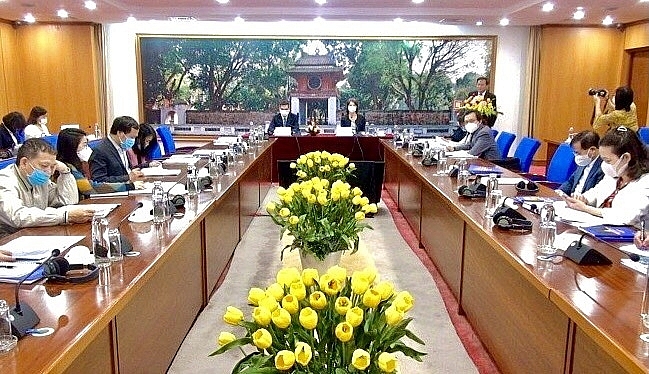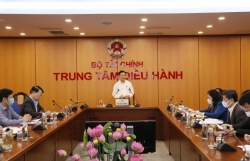 |
| Overview of the conference to review the implementation of the recommendations in the Vietnam Public Expenditure Assessment Report. |
Completing 65 of 68 recommendations on public expenditure
Reporting on the performance of the recommendations in the Public Expenditure Assessment Report and 5-year financial policy orientation (2021-2025 period) at the conference to review the implementation of the recommendations of the Vietnam Public Expenditure Assessment Report held on November 18, Deputy Director of the State Budget Department Nguyen Minh Tan said 65 of 68 recommendations in the report were applied, 41 of 68 recommendations were completed and three of 68 recommendations have not been implemented.
The implementation of the recommendations has helped perfect the socialist-oriented market economy institutions, improve the business investment environment, effectively mobilize, allocate and use resources and ensure social security and strengthen combat corruption and wastefulness.
In addition, it has helped Vietnam apply international practices on public expenditure management; increase publicity, transparency and accountability in association with autonomy of local authorities and budget-using units.
Nguyen Minh Tan said the public expenditure assessment report has three main groups of recommendations related to the following contents: ensuring fiscal sustainability; better aligning public expenditure with national priorities; and improving accountability for performance.
For the goal of ensuring fiscal sustainability, Nguyen Minh Tan said in terms of state budget collection, after five-year implementation of the recommendations, the state budget revenue increased and averaged 25.2% of GDP in the 2016-2020 period. The revenue from taxes and fees accounted for 21% of GDP. The domestic revenue gradually increased from 59.5% (2006-2010) and 68.7% (2011-2015), to 85.6% of total state budget revenue in 2020.
In terms of state budget spending, the state budget expenditure in the 2016-2020 period averaged about 28% of GDP (in the 2011-2015 period it was 29.5% of GDP); the estimates of recurrent expenditure decreased from 65.1% of total state budget expenditure in 2017 to less than 63.1% in 2020.
Regarding the balance of state budget and public debt, Mr. Nguyen Minh Tan said, the average state budget deficit in the 2016-2020 period was about 3.45% of GDP, satisfying the target of less than 3.9% of GDP according to Resolution 25/2016 /QH14 of the National Assembly.
The public debt dropped from 63.7% of GDP at end-2016 to 55.2% of GDP at end-2020, the indicators of Government debt balance and the national external debt balance were within safe limits.
Balancing the budget and public debt has contributed to ensuring national financial security, promoting economic growth, creating space to effectively respond to natural disasters, epidemics, climate change, and ensuring social security, thereby helping to succeeding in the “dual” goal of anti-pandemic and economic recovery and development.
The economic growth in 2020 reached 2.91% – in the group of countries with the highest growth rate; maintaining the credit rating and raising the outlook, said Mr. Nguyen Minh Tan.
Accelerating digitization to expand tax revenue base
At the conference, assessing the impact of the pandemic on the economies of the world and Vietnam, Ms. Dorsati Madani, Senior Economist at the World Bank said the Covid-19 pandemic has affected global growth, including Vietnam.
The pandemic has led to a dramatic loss of human life worldwide and in Vietnam and hampered achievements of extreme poverty reduction around the world since the 1990s, in which it mostly affected low-income households, workers in the informal economic sector and women.
The pandemic has resulted in a sharp decrease in revenue due to the closure of economic activities, tax exemption and reduction to support businesses; the deterioration in financial health of SOEs; increase in spending, including recurrent expenditure, due to the implementation of support packages.
Proposing solutions for Vietnam in budget collection, Ms. Dorsati Madani said that in the short term, it is necessary to strengthen compliance risk management and management of large tax payers.
In the medium term, to support the Socio-Economic Development Strategy, it is necessary to expand the tax revenue base through the application of green taxes (carbon taxes), digital economy taxes and property taxes, and promote digitization to expand tax collection to the informal economic sector.
As for policies on spending and public investment management, according to Ms. Dorsati Madani, in the short term, spending increases but must be more effective. In public investment management, it must be more flexible in capital use; harmonize administrative processes to expedite planning, budget allocation, procurement and disbursement. Budget using units also have to better forecast the project implementation plan to disburse capital under the plan.
 | Strive to complete the financial and budgetary tasks in 2021 VCN – The Ministry of Finance held an online conference to deploy financial and budgetary tasks in … |
In the medium and long term, it is necessary to invest in efficient buildings, especially in green and sustainable technology to create a foundation for economic transformation in the foreseeable future and institutionalize flexibility in public investment management by applying a rolling medium-term investment plan to quickly allocate and transfer capital to ready-to-go projects, said Ms. Dorsati Madani.
